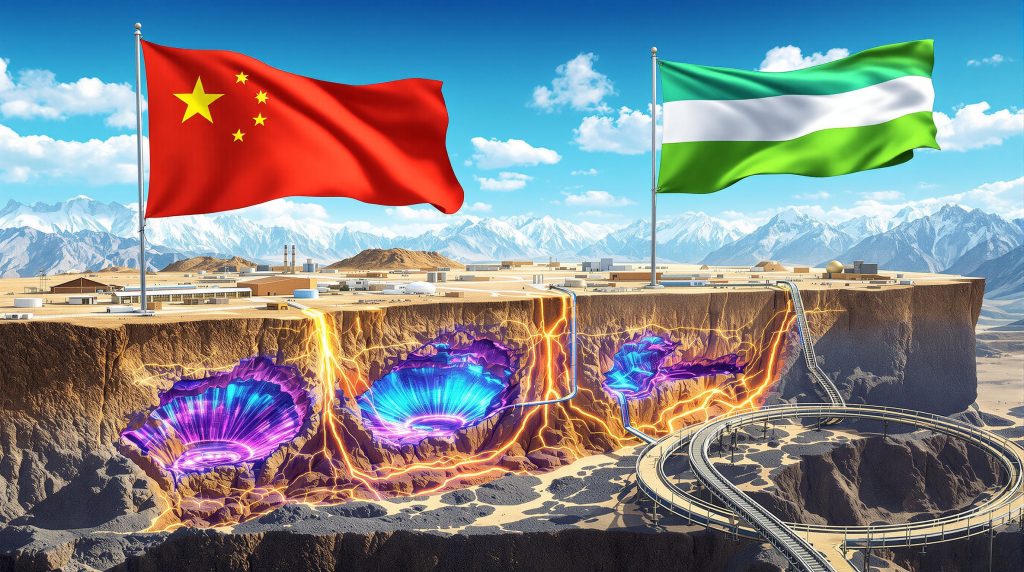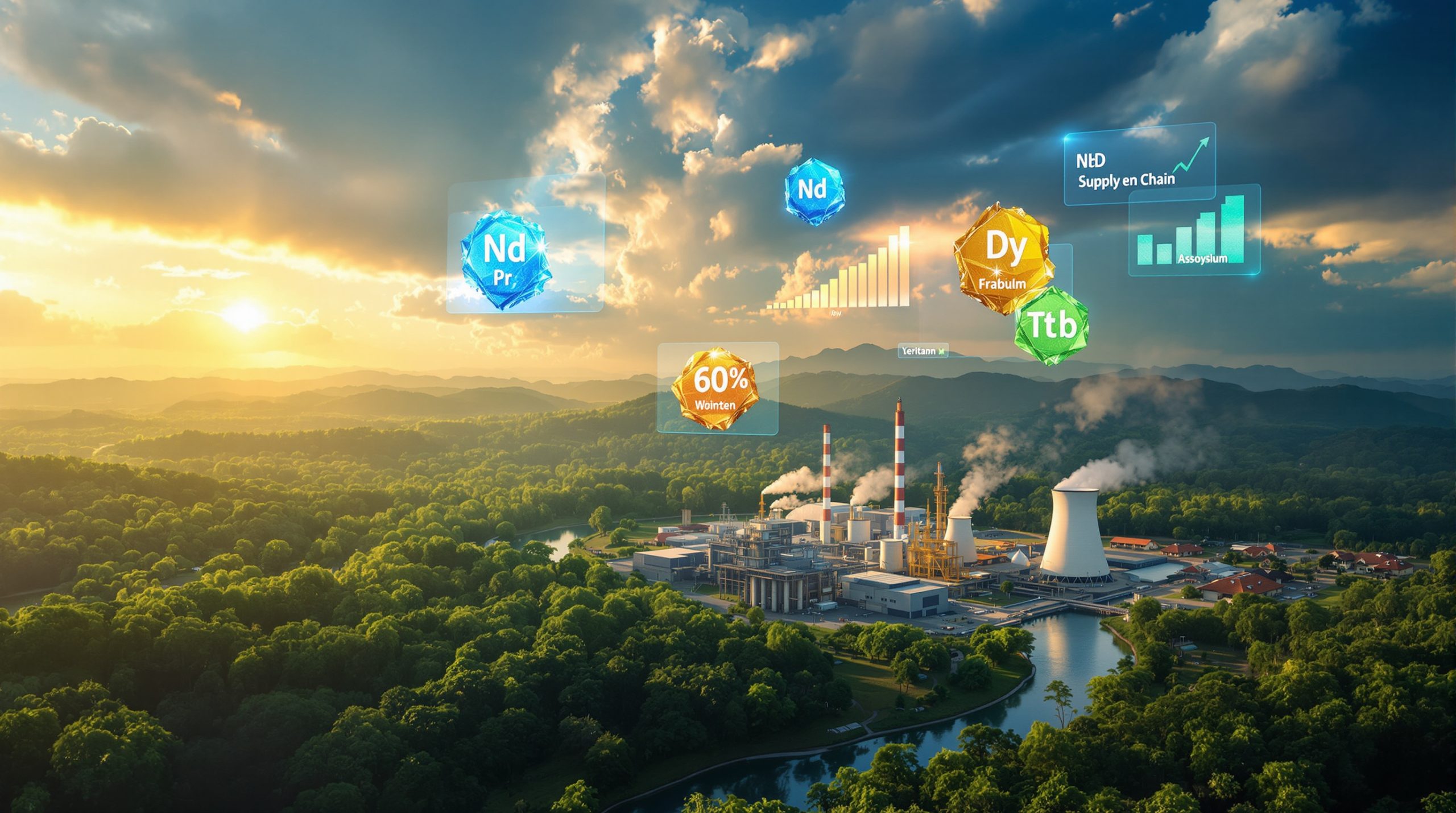The Strategic Foundation of Kazakhstan-Uzbekistan Rare Earth Cooperation
Central Asia stands poised to reshape global critical minerals supply chains through an unprecedented partnership between Kazakhstan and Uzbekistan. The establishment of their bilateral geological working group represents far more than diplomatic cooperation—it signals a calculated entry into the rare earth markets at a time when supply chain diversification has become a strategic imperative for nations worldwide.
This Kazakhstan and Uzbekistan rare earth partnership emerges against a backdrop of mounting concerns over supply chain concentration. With China maintaining control over approximately 80% of global rare earth processing capacity, governments and industries are actively seeking alternative sources for these critical materials that power everything from electric vehicles to wind turbines and military defence systems.
The timing of this collaboration reflects broader geopolitical shifts in resource security. Both nations possess documented mineral resources that have remained largely untapped for commercial rare earth production, sitting strategically outside the traditional spheres of influence that dominate current supply chains.
Understanding Current Market Vulnerabilities and Supply Chain Risks
The global rare earth industry faces unprecedented concentration risks that extend far beyond simple market dominance. China's control encompasses not just mining operations but the entire midstream processing infrastructure required to transform raw materials into usable industrial inputs.
Furthermore, recent developments highlight the vulnerability of supply chains, with uranium market volatility demonstrating how geopolitical tensions can rapidly impact critical mineral markets.
Critical Dependencies in Rare Earth Processing
The vulnerability becomes apparent when examining the processing pipeline:
• Separation technology: Complex chemical processes requiring specialised facilities and expertise
• Refining capabilities: Advanced metallurgical operations producing high-purity materials
• Environmental compliance: Sophisticated waste management systems for radioactive and chemical byproducts
• Quality control: Consistent production standards meeting industrial specifications
Western nations have found themselves increasingly dependent on Chinese processing capabilities even when raw materials originate elsewhere. This dependency creates strategic vulnerabilities that extend beyond economic considerations into national security concerns.
Geopolitical Implications of Supply Concentration
Recent trade tensions have highlighted the weaponisation potential of rare earth supply chains. Export restrictions, quota systems, and processing bottlenecks can quickly disrupt industries far removed from mining operations. The semiconductor shortage of 2020-2022 demonstrated how supply chain vulnerabilities cascade through interconnected global manufacturing networks.
The Kazakhstan and Uzbekistan rare earth partnership positions Central Asia as a potential alternative that operates outside traditional geopolitical alignments, offering supply chain diversification opportunities for multiple regions simultaneously.
Kazakhstan's Mineral Infrastructure and Processing Capabilities
Kazakhstan brings substantial advantages to this partnership through its established mining sector and processing infrastructure. The nation's uranium industry, which produces approximately 40% of global uranium supply, provides a foundation of expertise in handling radioactive materials—a critical consideration since rare earth deposits often contain thorium and uranium concentrations.
However, recent challenges in the sector, including a uranium mining update from neighbouring regions, underscore the importance of strategic planning for mineral extraction operations.
Existing Industrial Assets
The country's mineral processing capabilities include several facilities that could potentially be adapted or expanded for rare earth operations:
| Facility Type | Current Focus | Potential Application | Location |
|---|---|---|---|
| Uranium enrichment plants | Nuclear fuel cycle | Heavy rare earth processing | Multiple regions |
| Copper refineries | Base metal production | Light rare earth separation | Eastern Kazakhstan |
| Chemical processing complexes | Industrial chemicals | Rare earth compound production | Northern regions |
Technical Expertise and Workforce Development
Kazakhstan's mining sector employs over 500,000 workers with experience in complex metallurgical operations. This workforce foundation, combined with established relationships with international technology providers, creates opportunities for rapid capability development in rare earth processing.
The country's National Mining Academy and partnerships with international educational institutions provide pathways for specialised training in rare earth separation technologies. This educational infrastructure addresses one of the most significant barriers to rare earth industry development: the scarcity of qualified technical personnel.
Uzbekistan's Mineral Sector Transformation and Strategic Positioning
Uzbekistan's approach to rare earth development reflects broader economic liberalisation efforts that have transformed the country's investment landscape since 2016. The government's commitment to mineral sector modernisation includes comprehensive regulatory reforms and substantial financial commitments.
In addition, the broader context of critical minerals energy transition initiatives provides additional momentum for these development efforts.
Policy Framework and Investment Climate
Recent policy developments have created unprecedented opportunities for foreign investment:
• Streamlined licensing procedures: Simplified permitting for exploration and development projects
• Tax incentives: Preferential treatment for strategic mineral investments
• Foreign ownership rights: Expanded opportunities for international mining companies
• Infrastructure development: Government-backed transportation and utility investments
Documented Mineral Resources
Geological surveys conducted during the Soviet era identified significant rare earth concentrations in several regions, particularly around Navoi province. These deposits benefit from proximity to existing gold mining operations and processing facilities, creating opportunities for integrated extraction and processing operations.
The Uzbekistan Geological Survey estimates potential rare earth reserves that could support commercial operations, though comprehensive modern assessment remains ongoing. Early indications suggest concentrations of both light and heavy rare earth elements, with particular potential for neodymium and dysprosium—critical components for permanent magnet production.
International Partnership Requirements and Technology Transfer
Both Kazakhstan and Uzbekistan face the same fundamental challenge: neither country currently operates commercial-scale rare earth separation facilities. This gap creates both obstacles and opportunities for international partnerships.
The development of raw materials facility trends in Europe provides valuable insights into how emerging markets can structure their processing capabilities.
Critical Technology Gaps
The development of viable rare earth industries requires addressing several technical capabilities:
"Separation Technology: Advanced chemical processes using solvent extraction, ion exchange, and precipitation techniques to isolate individual rare earth elements from mixed concentrates."
"Environmental Management: Sophisticated systems for handling radioactive waste, acid mine drainage, and chemical processing byproducts that meet international environmental standards."
"Quality Assurance: Laboratory capabilities and process controls ensuring consistent product specifications for industrial applications."
Potential Partnership Models
Several international partnership structures could accelerate development:
Technology Licensing Agreements: Partnerships with established rare earth processors from Japan, South Korea, or Australia could provide proven separation technologies while allowing local ownership of operations.
Joint Venture Structures: Combining international expertise with local resources and government support could share risks while ensuring technology transfer.
Phased Development Approach: Starting with concentrate production and gradually building processing capabilities could minimise initial capital requirements while developing local expertise.
Competitive Analysis Against Other Emerging Rare Earth Regions
The Kazakhstan and Uzbekistan rare earth partnership faces competition from other regions seeking to challenge Chinese market dominance. Understanding these competitive dynamics helps assess the partnership's potential success.
Regional Comparison Matrix
| Region | Resource Base | Processing Capability | Political Stability | Development Timeline |
|---|---|---|---|---|
| Central Asia | Documented deposits | Limited, requires development | Moderate, improving | 5-8 years |
| Australia | Large, diverse deposits | Existing, expanding | High | 2-4 years |
| North America | Significant reserves | Developing rapidly | High | 3-5 years |
| Africa | Substantial potential | Minimal infrastructure | Variable | 7-10 years |
Competitive Advantages of Central Asian Development
The Kazakhstan-Uzbekistan partnership offers several unique advantages:
Geopolitical Neutrality: Both countries maintain relationships with China, Russia, Europe, and Asia simultaneously, avoiding the trade restrictions that might affect other regions.
Cost Structure: Lower labour and operational costs compared to developed countries, while maintaining better infrastructure than many developing regions.
Resource Integration: Opportunities to combine rare earth extraction with existing uranium, copper, and gold operations, improving overall project economics.
Investment Opportunities and Risk Assessment Framework
The rare earth partnership creates multiple investment vectors for international capital, each with distinct risk-reward profiles and development timelines. However, investors should also consider how mining industry innovation affects long-term prospects for new projects.
Direct Investment Opportunities
Exploration and Development: Early-stage investments in geological surveys, drilling programs, and resource assessment offer high-risk, high-reward exposure to potential discoveries.
Processing Infrastructure: Mid-stage investments in separation facilities, refineries, and chemical processing plants require substantial capital but offer more predictable returns once operational.
Supporting Industries: Investments in transportation, power generation, and technical services provide exposure to sector growth with lower geological risk.
Risk Mitigation Strategies
Successful investment in Central Asian rare earth development requires comprehensive risk management:
• Political Risk Insurance: Coverage for policy changes, expropriation, and currency convertibility issues
• Phased Investment Approach: Staged capital deployment aligned with project milestones and market validation
• Diversified Partnership Structure: Multiple international stakeholders reducing single-country dependency
• Local Stakeholder Engagement: Strong relationships with government agencies, communities, and local businesses
Technical Challenges and Processing Requirements
Developing commercially viable rare earth operations in Central Asia requires overcoming significant technical hurdles that extend beyond basic mining operations. The complexity of these operations reflects broader challenges in the global rare earth supply chain.
Separation Technology Requirements
Rare earth separation represents one of the most technically complex processes in modern metallurgy. The chemical similarity between rare earth elements requires sophisticated processing systems:
Solvent Extraction Systems: Multi-stage chemical separation processes using specialised organic compounds to selectively extract individual elements from mixed solutions.
Ion Exchange Technologies: Advanced resin systems for purifying and concentrating specific rare earth elements to industrial specifications.
Precipitation and Crystallisation: Controlled chemical processes for producing high-purity rare earth compounds suitable for downstream applications.
Environmental and Regulatory Compliance
Rare earth processing generates significant environmental challenges that must be addressed through advanced management systems:
"Radioactive Waste Management: Proper handling and disposal of thorium and uranium byproducts requires specialised facilities and long-term storage solutions."
"Chemical Waste Treatment: Advanced systems for neutralising acids, treating contaminated water, and managing toxic byproducts from chemical separation processes."
"Air Quality Control: Sophisticated filtration and monitoring systems preventing release of particulate matter and chemical vapours."
Long-term Market Implications and Supply Chain Evolution
The success of Central Asian rare earth development could fundamentally reshape global supply chains, creating new trade relationships and market dynamics. Furthermore, recent developments in strategic resource cooperation between the two nations demonstrate the growing importance of regional partnerships.
Supply Chain Diversification Benefits
A functioning Kazakhstan and Uzbekistan rare earth partnership would provide several strategic advantages:
Reduced Concentration Risk: Alternative supply sources outside Chinese control could moderate price volatility and supply security concerns.
Regional Processing Hubs: Central Asian facilities could serve European, Asian, and Middle Eastern markets simultaneously, reducing transportation costs and delivery times.
Technology Development: Increased global processing capacity could accelerate innovation in separation technologies and environmental management systems.
Timeline and Development Expectations
Realistic expectations for Central Asian rare earth development involve extended timelines:
Years 1-3: Comprehensive geological surveys, resource quantification, and technology partnership agreements
Years 4-6: Pilot processing facilities, infrastructure development, and workforce training programs
Years 7-10: Commercial-scale operations, supply chain integration, and market share development
In addition, recent US-Central Asia minerals cooperation initiatives provide a framework for how international partnerships might develop in this sector.
Investment Success Metrics
Measuring the partnership's success requires multiple indicators beyond simple production volumes:
• Technology Transfer Effectiveness: Development of local technical expertise and processing capabilities
• Environmental Compliance: Meeting international standards for waste management and ecological protection
• Market Integration: Successful entry into global supply chains with consistent product quality
• Economic Impact: Contribution to regional economic development and employment creation
The Kazakhstan and Uzbekistan rare earth partnership represents a strategic positioning for the evolving critical minerals landscape. While significant challenges remain in technology development, environmental management, and market integration, the partnership offers genuine potential for supply chain diversification away from current concentration risks.
Success will depend on sustained international collaboration, substantial capital investment, and long-term commitment to building processing capabilities that meet global industrial standards. For investors and industry stakeholders, this partnership warrants careful monitoring as Central Asia's entry into rare earth markets could reshape global supply dynamics over the coming decade.
Looking for Strategic Exposure to Critical Mineral Discoveries?
Discovery Alert's proprietary Discovery IQ model delivers instant notifications on significant ASX mineral discoveries, helping investors identify actionable opportunities in the rapidly evolving critical minerals sector. Begin your 30-day free trial today and position yourself ahead of the market with real-time insights into potential transformative discoveries.




